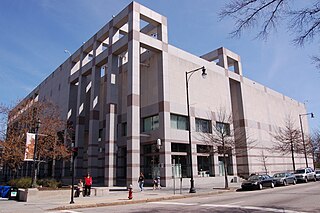
Cedarburg is a city in Ozaukee County, Wisconsin, United States. Located about 20 miles (32 km) north of Milwaukee and in close proximity to Interstate 43, it is a suburban community in the Milwaukee metropolitan area. The city incorporated in 1885, and at the time of the 2020 census the population was 12,121.

St. Joan of Arc Chapel is a Roman Catholic chapel today located in Milwaukee, Wisconsin, United States, on the campus of Marquette University, in the Archdiocese of Milwaukee. It was dedicated to Joan of Arc on 26 May 1966, after it had been moved from its previous location on Long Island, New York. It was originally built in the Rhône River Valley in France.

The Rockwell Automation Headquarters is an office building located in Milwaukee, Wisconsin. The building is known for once having the largest four-faced clock in the world.

The Circus World Museum is a museum complex in Baraboo, Wisconsin, devoted to circus-related history. The museum features circus artifacts and exhibits and hosts daily live circus performances throughout the summer. It is owned by the Wisconsin Historical Society and operated by the non-profit Circus World Museum Foundation. The museum was the major participant in the Great Circus Parade held from 1963 to 2009.

SS Milwaukee was a train ferry that served on Lake Michigan. It was launched in 1902 and sank with all hands off Milwaukee on October 22, 1929. Fifty-two men were lost with the vessel.
The Holiday Folk Fair is an annual three-day festival celebrating cultures from around the world. Thousands of visitors attend the Fair each year. It is held the weekend before Thanksgiving in West Allis, Wisconsin, at the Wisconsin Exposition Center of Wisconsin State Fair Park. It is billed as the largest indoor international festival in America. The Fair is sponsored and organized by the International Institute of Wisconsin, a not-for-profit social service agency that promotes cultural understanding. Al Durtka is its current president.
RiverSculpture! are public art displays found along the Milwaukee Riverwalk in downtown Milwaukee, Wisconsin. Information kiosks stationed near each presentation offer self-guided walking tours of this annual outdoor exhibition.

The Museum of Appalachia, located in Norris, Tennessee, 20 miles (32 km) north of Knoxville, is a living history museum that interprets the pioneer and early 20th-century period of the Southern Appalachian region of the United States. Recently named an Affiliate of the Smithsonian Institution, the museum is a collection of more than 30 historic buildings rescued from neglect and decay and gathered onto 63 acres (25 ha) of picturesque pastures and fields. The museum also preserves and displays thousands of authentic relics, maintains one of the nation's largest folk art collections, and hosts performances of traditional Appalachian music and annual demonstrations by hundreds of regional craftsmen.

The Milwaukee Public Museum (MPM) is a natural and human history museum in downtown Milwaukee, Wisconsin. The museum was chartered in 1882 and opened to the public in 1884; it is a not-for-profit organization operated by the Milwaukee Public Museum, Inc. MPM has three floors of exhibits and the first Dome Theater in Wisconsin.

Schuster's, officially Ed. Schuster & Co., was a department store chain, founded in 1883, in Milwaukee, Wisconsin, and it is now defunct.

The North Carolina Museum of History is a history museum located in downtown Raleigh, North Carolina. It is an affiliate through the Smithsonian Affiliations program. The museum is a part of the Division of State History Museums, Office of Archives and History, an agency of the North Carolina Department of Cultural Resources.

The Polish Museum of America is located in West Town, in what had been the historical Polish Downtown neighborhood of Chicago. It is home to numerous Polish artifacts, artwork, and embroidered folk costumes in its growing collection. Founded in 1935, it is one of the oldest ethnic museums in the United States and a Core Member of the Chicago Cultural Alliance, a consortium of 25 ethnic museums and cultural centers in Chicago.

The Grohmann Museum, at the Milwaukee School of Engineering, houses an art collection dedicated to the evolution of human work. The museum opened on October 27, 2007 and is located at 1000 N. Broadway, Milwaukee, Wisconsin, United States. It is next to the German-English Academy Building.

Sea Form (Atlantic) (BH 362) is a 1964 bronze sculpture by English artist Barbara Hepworth. It measures 204 cm × 107 cm × 73 cm (80 in × 42 in × 29 in).
John Luick was the founder of Luick Ice Cream, which later became part of Sealtest Dairy.
![<span class="mw-page-title-main">William Plankinton Mansion</span> House built in 1876[1] by the millionaire meatpacking entrepreneur John Plankinton](https://upload.wikimedia.org/wikipedia/commons/thumb/b/bf/Wm_Plankinton_house_1895.jpg/320px-Wm_Plankinton_house_1895.jpg)
The William Plankinton Mansion was built in 1876 by the millionaire meatpacking entrepreneur John Plankinton and presented as a wedding gift when his son William Plankinton married Mary Ella Woods. Located at 1529 W. Wisconsin Avenue in Milwaukee, Wisconsin, the Victorian style residence was designed by Edward Townsend Mix, the most prominent Milwaukee architect of that era.
The Cedarburg History Museum is located in the historic Hilgen & Schroeder Mill Store, which is also home to the Cedarburg Chamber of Commerce and Cedarburg Visitor Center. The museum acquired the space in 2015 and began programming under the auspices of the Cedarburg Cultural Center in 2017. The Cedarburg History Museum has since 2019 functioned independently of the Cedarburg Cultural Center. The museum offers local photography collections in addition to its rotating exhibits.

Fred Berman, born Fred Jean Berman, was a Jewish American abstract artist.
Maximillian (Max) Margius Fernekes was an American artist known for his etching and watercolors of the Wisconsin cityscapes. He has been called the Norman Rockwell of Mineral Point and Milwaukee, Wisconsin.













![<span class="mw-page-title-main">William Plankinton Mansion</span> House built in 1876[1] by the millionaire meatpacking entrepreneur John Plankinton](https://upload.wikimedia.org/wikipedia/commons/thumb/b/bf/Wm_Plankinton_house_1895.jpg/320px-Wm_Plankinton_house_1895.jpg)
